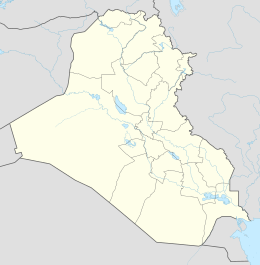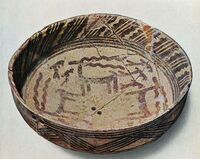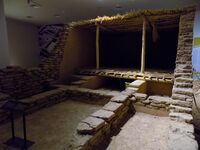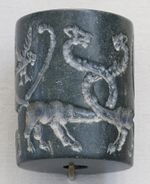ثقافة حسونة
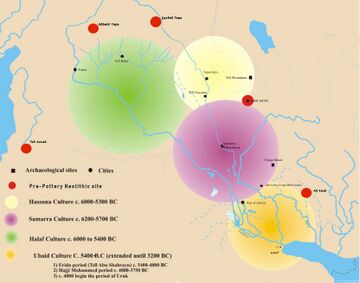
ثقافة حسونة (بالأصفر)، بجانب Samarra, Halaf و Ubaid cultures. | |
| النطاق الجغرافي | بلاد الرافدين |
|---|---|
| الفترة | العصر الحجري الحديث |
| التواريخ | حوالي 6000 ق.م. |
| الموقع النمطي | تل حسونة |
| المواقع الرئيسية | تل شمشارة |
| سبقها | Pre-Pottery Neolithic B, Yarmukian culture, Halaf culture |
| تلاها | Ubaid period |
ثقافة حسونة هي ثقافة أثرية من العصر الحجري الحديث في أعالي الرافدين يعود تاريخها إلى مطلع الألفية السادسة ق.م. وهي مسماة على اسم مضرب التسمية تل حسونة في العراق. المواقع الأخرى التي عُثر فيها على مواد من ثقافة حسونة تضم تل شمشارة.
. . . . . . . . . . . . . . . . . . . . . . . . . . . . . . . . . . . . . . . . . . . . . . . . . . . . . . . . . . . . . . . . . . . . . . . . . . . . . . . . . . . . . . . . . . . . . . . . . . . . . . . . . . . . . . . . . . . . . . . . . . . . . . . . . . . . . . . . . . . . . . . . . . . . . . . . . . . . . . . . . . . . . . . .
الوصف
By around 6000 BC people had moved into the foothills (piedmont) of northernmost Mesopotamia where there was enough rainfall to allow for "dry" agriculture in some places. These were the first farmers in northernmost Mesopotamia. They made Hassuna-style pottery (cream slip with reddish paint in linear designs). Hassuna people lived in small villages or hamlets ranging 2–8 acres (0.81–3.24 ha).
At Tell Hassuna, adobe dwellings built around open central courts with fine painted pottery replace earlier levels with crude pottery. Hand axes, sickles, grinding stones, bins, baking ovens, and numerous bones of domesticated animals reflect settled agricultural life. Female figurines have been related to worship and jar burials within which food was placed related to belief in afterlife. The relationship of Hassuna pottery to that of Jericho suggests that village culture was becoming widespread.[1]
ما قبل حسونة الأولية
More recently, the concept of a very early 'Pre-Proto-Hassuna' pottery tradition has been introduced by some scholars. This has been prompted by more recent discoveries of still earlier pottery traditions. Pre-Proto-Hassuna refers to the Late Neolithic period in Upper Mesopotamia when the ceramic containers were just being introduced.[2] The pottery vessels were still very few in number in these early settlements. At that time, the main emphasis was on the pottery with a mineral temper, as opposed to the plant-tempered pottery which came to predominate later.
The time frame for this period was about 7000-6700 BC,[2] and at this time stone vessels and White Ware were still being used in addition to pottery.[3] Because of the narrow local emphasis in many pottery studies as of now, these earliest pottery traditions may be known in literature as:
- Pre-Proto-Hassuna (in Khabur, and northern Iraq)
- Initial Pottery Neolithic (in Balikh River area, for example Tell Sabi Abyad)[4]
- Transitional (in Turkish Euphrates area; main sites are Mezraa Teleilat and Akarcay Tepe, with pottery dated to ح. 6800 BC)
- Halula I (in Syrian Euphrates area; the main site is Tell Halula)
- Rouj 2a (in Northern Levant); several archaeological sites are located in the Rouj basin, Idlib, Syria).[5]
Nevertheless, all of these nomenclatures may refer to quite similar types of pottery, depending on some specific geographic region of Upper Mesopotamia.[3]
حسونة الأولية
This period denotes a higher use of ceramics than with the pre-proto-Hassuna period.[6] The site of Umm Dabaghiyah (de:Umm Dabaghiyah-Sotto-Kultur), in the same area of Iraq, is believed to have the earliest pottery in this region, and is sometimes described as a 'Proto-Hassuna culture' site. Other related sites in the area are Sotto and Yarim Tepe I, having 585 recorded ceramic fragments. They were found by archaeologist A.A. Bobrinsky.[6] Another pre-Hassuna or proto-Hassuna site in Iraq is Tell Maghzaliyah. Yet another site with proto-Hassuna pottery is Ginnig.[7]
The time frame for this period was about 6700-6300 BC.[2]
حسونة العتيقة
‘Archaic Hassuna’ has been introduced more recently as a new period different to proto-Hassuna.[8] This period is recorded to have a decrease in the concentration of dung in ceramic production and an increase in the use of two-layer slabs in construction, although they were used prior to this period. During this timeframe, pottery kilns start to show up in many sites.[6] The changing patterns within pottery may also connect with an increase in cultural diffusion. The type site, Tell Hassuna, is also recorded to possess Archaic Hassuna artifacts.[9]
The time frame for this period was about 6300-6000 BC.[2]
اللقى
Reconstitution of Neolithic dwelling in northern Mesopotamia (Akarcay Tepe II)
Reconstitution of Neolithic dwelling in northern Mesopotamia (Akarcay Tepe II)
انظر أيضاً
المراجع
- ^ "The oldest pottery Neolithic of Upper Mesopotamia : New evidence from Tell Seker al-Aheimar, the Khabur, northeast Syria - Persée". Persee.fr. doi:10.3406/paleo.2005.5125. Retrieved January 18, 2017.
- ^ أ ب ت ث "Collections Online | British Museum". www.britishmuseum.org. Retrieved 2022-05-08.
- ^ أ ب Reinhard Bernbeck and Olivier Nieuwenhuyse (2013), ESTABLISHED PARADIGMS, CURRENT DISPUTES AND EMERGING THEMES: THE STATE OF RESEARCH ON THE LATE NEOLITHIC IN UPPER MESOPOTAMIA Publications on Archaeology of the Leiden Museum of Archaeology (PALMA), Brepols pub. (Turnhout, Belgium), 17-37
- ^ The very oldest pottery of Tell Sabi Abyad (and of Syria), 7000-6700 BC Archived 2015-07-23 at the Wayback Machine http://www.sabi-abyad.nl
- ^ "Syro-Japanese Archaeological Investigation - Rouj Basin Project, Syria". Archived from the original on 2020-02-24. Retrieved 2017-10-24.
- ^ أ ب ت "Hassuna Culture Research Papers - Academia.edu". www.academia.edu. Retrieved 2022-05-08.
- ^ Watkins, Trevor (1992-12-01). "Pushing Back the Frontiers of Mesopotamian Prehistory". The Biblical Archaeologist. 55 (4): 176–181. doi:10.2307/3210311. ISSN 0006-0895. JSTOR 3210311.
- ^ Petrova, Natalia Yu. (2012). "A Technological Study of Hassuna Culture Ceramics (Yarim Tepe I settlement)". Documenta Praehistorica XXXIX. 39: 75–82. doi:10.4312/DP.39.5. S2CID 111376528.
- ^ Thompson, Barry Edward (9 May 2022). THE ARCHAEOLOGY OF NORTHERN MESOPOTAMIA (PDF). Barry Edward Thompson. p. 49.
